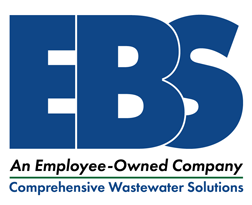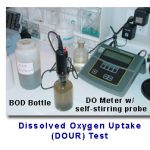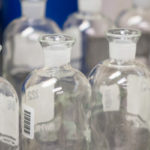The pH of the environment has a profound effect on the rate of microbial growth. pH affects the function of metabolic enzymes. Acidic conditions (low pH) or basic conditions (high pH) alter the structure of the enzyme and stop growth. Most microorganisms do well within a pH range of 6.5 to 8.5. However, some enzyme systems can tolerate extreme pHs and will thrive in acidic or basic environments. Fungi, for example, do well in an acidic environment. Most bacteria and protozoa, however, grow best in neutral (pH 7) environments. Abnormal or irregular pH in biological treatment processes can result in a significant decrease in the rate of removal of organic compounds from the environment, which will affect the biochemical oxygen demand (BOD) measurements.
Many plants must control the pH of their process effluent within an acceptable range before it is mixed with biomass in the Aerated Stabilization Basin (ASB) or Activated Sludge System. Even short-term exposure (exposure lasting less than one minute) to extreme pH causes significant microbial destruction. Some influents (process effluents) are slightly on the basic side with pHs between 9.0 and 10.5. Because bacteria generate CO2 (an acidic gas) as a by-product of metabolism, they will self-regulate the pH to some extent, as long as the pH is not so severe as to completely stop the bacteria’s metabolism.
pH approximates the concentration of hydrogen ions in a solution. The pH value is the negative logarithm (base 10) of the concentration of H+ ions in the solution. In the laboratory, pH is measured by electrometric pH measurement which is the determination of the activity of the hydrogen ions by potentiometric measurement using a standard hydrogen electrode and a reference electrode. The pH probe is placed in the sample (while stirring) and the number is recorded once the readings have stabilized. Because it is on a logarithmic scale, it will take ten times as much acid or base (caustic) to raise or lower the pH two units as it did to raise or lower it one unit. For example, if it takes 10 gallons of a particular acid to lower the pH of an influent from 10 to a pH of 9, it will take 100 gallons to lower it from a pH of 10 to a pH of 8.





